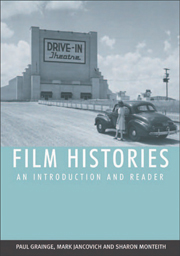Book contents
- Frontmatter
- Contents
- Preface
- Part I Film History from its Origins to 1945
- 1 The Emergence of Cinema
- 2 Organising Early Film Audiences
- 3 Nationalism, Trade and Market Domination
- 4 Establishing Classical Norms
- 5 The Age of the Dream Palace and the Rise of the Star System
- 6 Competing with Hollywood: National Film Industries outside Hollywood
- 7 The Rise of the Studios and the Coming of Sound
- 8 Realism, Nationalism and ‘Film Culture’
- 9 Adjustment, Depression and Regulation
- 10 Totalitarianism, Dictatorship and Propaganda
- 11 The Common People, Historical Drama and Preparations for War
- 12 Wartime, Unity and Alienation
- Part II Film History from 1946 to the Present
- Bibliography
- Copyright Acknowledgements
- Index
7 - The Rise of the Studios and the Coming of Sound
from Part I - Film History from its Origins to 1945
Published online by Cambridge University Press: 05 August 2013
- Frontmatter
- Contents
- Preface
- Part I Film History from its Origins to 1945
- 1 The Emergence of Cinema
- 2 Organising Early Film Audiences
- 3 Nationalism, Trade and Market Domination
- 4 Establishing Classical Norms
- 5 The Age of the Dream Palace and the Rise of the Star System
- 6 Competing with Hollywood: National Film Industries outside Hollywood
- 7 The Rise of the Studios and the Coming of Sound
- 8 Realism, Nationalism and ‘Film Culture’
- 9 Adjustment, Depression and Regulation
- 10 Totalitarianism, Dictatorship and Propaganda
- 11 The Common People, Historical Drama and Preparations for War
- 12 Wartime, Unity and Alienation
- Part II Film History from 1946 to the Present
- Bibliography
- Copyright Acknowledgements
- Index
Summary
American cinema's domination of world markets coincided with the rise of the Hollywood studios. The Hollywood Studio System would properly take hold by 1930 once five companies – Metro-Goldwyn-Mayer, RKO, Fox (later Twentieth-Century Fox), Warner Bros. and Paramount – had emerged victorious from increasing competition and a scrimmage of mergers and takeovers of production and distribution companies. By 1930 it is estimated that there were around 24,000 cinemas in the US with the five major studios controlling at least 50 per cent of the total industry output. By 1931, D. W. Griffith had made his last film and the film industry was primed to establish the classical Hollywood era with the new technology of sound. In fact, the era from the coming of the sound film to the end of the 1940s is often called Hollywood's ‘Golden Age’. During those years the Hollywood film factory fitted a Fordist model of capitalist mass production. In order to understand the success of the American film industry, it is important to examine the 1920s: the decade in which the studios employing thousands of people changed the face of Los Angeles and in which Thomas Ince's idea of the ‘factory system’ of production took hold.
- Type
- Chapter
- Information
- Film HistoriesAn Introduction and Reader, pp. 147 - 164Publisher: Edinburgh University PressPrint publication year: 2007



